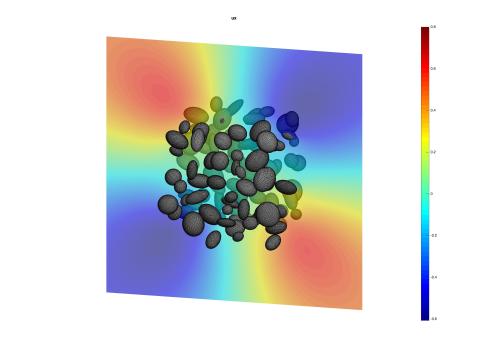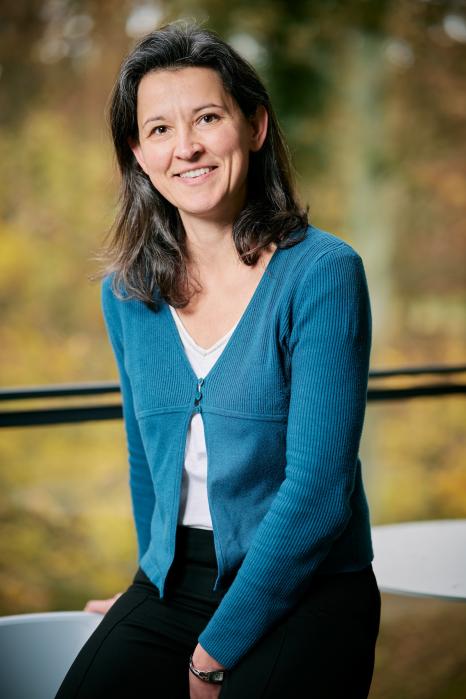
Aline Lefebvre-Lepot: modelling and simulating granular flows
Promoted to Research Director at the National Centre for Scientific Research (CNRS) in October 2023, mathematician Aline Lefebvre-Lepot also joined CentraleSupélec's Mathematics Federation. Her major? Studying mathematical models and their properties and developing algorithms for simulating granular media and viscous suspensions for a better understanding of their behaviour.
"Have you ever poured rice through a funnel and noticed that the grains sometimes get stuck? That is one of the phenomena we aim to explain using numerical simulations. These are based on the development of mathematical models of contact, which is my core expertise," explains Aline Lefebvre-Lepot. Within CentraleSupélec's Mathematics Federation, which brings together some thirty mathematicians conducting research directly linked to applications, the researcher, who has always claimed to apply mathematics to physics, is thriving in her new multidisciplinary research environment.
When the grains get stuck, mathematics comes to the rescue
Whether dry or immersed in a fluid, how can we limit the grains becoming stuck during their flow? How fast do they flow? Under what conditions do they deform? Can grains of different sizes or characteristics be mixed or separated? Just some of the questions that arise in a wide range of areas of application, from the industrial production of granular materials (such as pastes made from grains in a viscous matrix), to environmental phenomena (like the erosion of coastal dunes or the flow of sediments in river beds) and even the storage of wheat in farmers' silos.
Finding the right algorithm
The physical phenomenon is not new. What motivates Aline Lefebvre-Lepot is finding the right equations to describe it. "Many questions remain since Einstein's theories. We understand the behaviour of dilute or semi-dilute systems (in which there are few particles, sufficiently far apart), but for very dense systems, these questions are still relevant." No matter where a particular grain of sand goes, the goal is to understand how the system flows globally at the macroscopic level by studying it at the microscopic level. "For a better understanding of the micro-macro link, we perform simulations of large numbers of grains. Since resolution at this level is particularly costly, we develop new mathematical models, which contain the physics and lead to efficient algorithms."
From mathematics to physics: the SCoPI (Simulation of Collections of Particles in Interaction) code
While these simulations help to advance physics, the mathematical study of models and algorithms is essential to ensure their efficiency and accuracy. "This leads to beautiful mathematics," such as the non-smooth convex analysis developed in the 1970s by J.J. Moreau or constrained optimisation. In 2016, Aline Lefebvre-Lepot described the SCoPI code for simulating granular materials. "Writing this code, along with its subsequent development, would not have been possible without the help of my co-workers Sylvain Faure and Loïc Gouarin, research engineers specialising in high-performance computing."
Used with other researchers from the Fluids, Automation and Thermal Systems Laboratory (FAST - Univ. Paris-Saclay, CNRS), SCoPi allows for the replication of an experiment and a better understanding of the behaviour of a dry granular material set in motion by a towed ball. "Our models do not always take into account all the physics of the experiment. Consequently, the idea is to say that if we observe phenomena, they come from what we have put into it. Not having modelled the solid friction between the grains, we learned that the observed behaviours were not due to this."
Enriching models and algorithms
During her thesis, supervised by Bertrand Maury of the Mathematics Laboratory of Orsay (LMO - Univ. Paris-Saclay, CNRS), Aline Lefebvre-Lepot also developed the viscous contact model. "It allows for the consideration of the lubrication phenomenon, that is, the effects of the fluid between particles when they are close to contact, by modelling it as sticky contact." In association with the Paris Institute of Planetary Physics (Institut de Physique du Globe de Paris - IPGP), the algorithm was further extended to take into account solid friction between particles. As all these methods were written in the same mathematical framework, they were integrated into the SCoPI code, so that the various physical phenomena were taken into account in the simulations.
While these contact models and algorithms worked very well for both dry granular media and suspensions when the particles are in contact or very close together, the additional question of resolving the fluid between particles arose in the case of suspensions. In 2021 the mathematician, together with her co-worker Flore Nabet, developed a numerical method to capture the behaviour of the fluid between these particles when they are close to each other but still far from contact.
Today, Aline Lefebvre-Lepot's research, conducted in partnership with Luiz Faria, focuses on deformable particles. "These consist of a membrane trapping a viscous fluid, itself immersed in a fluid. Applications lie in micro-swimmers (when such microscopically-sized entities deform to swim) or what is called microfluidics (when these vesicles are transported in microchannels)." Interdisciplinarity is a fundamental characteristic of Aline Lefebvre-Lepot's research, which was awarded the Blaise Pascal prize by the French Academy of Sciences in 2022.
Teaching as a means of communication
Aline Lefebvre-Lepot is also deeply committed to teaching. "In my final year of secondary school, then in the 2-year preparatory course for a competitive exam in Lille, I already aspired to become a professor and teach maths. Later, during my thesis, I was a teaching assistant and then a temporary teaching and research associate (ATER) at Université Paris-Saclay. Today, I still teach at École Polytechnique and will soon do so at CentraleSupélec." Teaching is a way for her to "take stock" of her research and an opportunity to inspire younger generations to pursue a career in mathematics. "Whether you are a girl or a boy, you should do what you love and believe in yourself. It is important that the teaching and research community encourage and support motivated students."
Aline Lefebvre-Lepot's own career path has been full of invaluable support. "When I was a final-year student in secondary school, I had an extraordinary maths teacher. During my 2-year preparatory course for a competitive exam, it was my maths teacher who steered me towards the magister degree in mathematics at the Orsay Faculty of Science." On completing her degree, she joined ENS Paris-Saclay through the third competitive entrance exam (2002-2004). She obtained her teaching qualification (agrégation) in 2003, before completing her 2nd year Master's degree and then her thesis at the Mathematics Laboratory of Orsay, and being recruited as a CNRS research fellow.
"I love doing mathematics, particularly if they can be applied in other disciplines. There's nothing more satisfying than using models and codes that one has developed. When they are passed on to other colleagues who then use them to create new knowledge, that's when I know I have succeeded in my job!" concludes Aline Lefebvre-Lepot.

